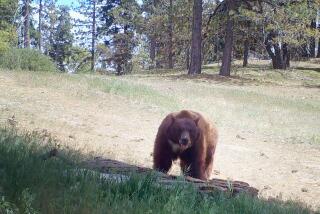Calling out to the wild
Could better communications help prevent things from going wrong between humans and wild animals? Some scientists on the frontiers of interspecies fraternizing think it’s possible to get across more than misjudged intentions. They believe humans should and can learn the language of animals, rather than vice versa.
Working in the method Jane Goodall pioneered some 30 years ago — of listening and watching animals in the field, not in captivity — these researchers are trying to crack the communications code between the species.
Denise Herzing, a research biologist and head of the Wild Dolphin Project, has spent the last 19 years with a pod of Atlantic spotted dolphins off the Bahamas. She has watched three generations grow to adulthood and recorded thousands of hours of videotape in an attempt to learn their language.
This year, using a translator created by acousticians at Carnegie Mellon University that can translate up to 20 human languages, she will try to create a meaning-related translation of their language.
Roger Fouts, in his 1997 book, “Next of Kin,” describes his decades of work with chimpanzees. A professor of psychology at Central Washington University and co-director with his wife, Deborah, of the Chimpanzee and Human Communication Institute, Fouts documents his two-way communication with a chimpanzee named Washoe and his family.
Brenda Peterson, an author in Washington state who has published several books on her experiences with wolves and orcas, writes about naturalists and scientists who are trying to search for a common language. One team, Paul Spong and Helena Simons of the Orca Lab, has spent 30 years listening to orca pods in British Columbia and can now identify individuals and their family members by sound.
“If anyone can crack the code,” Peterson says, “it’s them.”
This is a tiny sample from a field whose members differ from scientists of previous generations, or from veterinarians and animal behaviorists who, in many cases, continue to treat animals as objects.
“It used to be that once you crossed that line of objectivity,” Peterson says, “you could no longer be called a scientist. But that was a pseudo line. Now it is easier for a scientist to maintain his integrity in the field even as he establishes a commitment to the animals he studies. Scientists today have both quantitative data and intimate relationships with the animals they study.”
Another major change in the field, Herzing says, is that “the technology is now available to really help us with pattern recognition and recording and decoding. If they choose not to utilize our system, we’ll learn something about the process and go back and try again. It is my goal to live with these animals and to see who they are. Now we can give them the tools to say what they know.”
Ben White, a consultant for the Animal Welfare Institute, says he always believed if we could just break through the language barrier, we would stop treating animals so badly. He, for one, believes that Fouts broke the barrier, “and it didn’t change a thing.”






